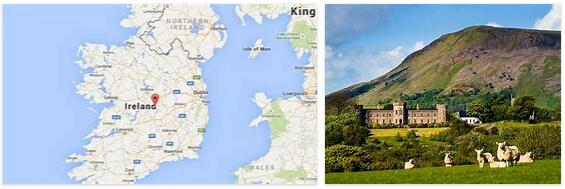Ireland, Irish Éire [eːriə], English Ireland [ a ɪ ələnd], officially Irish Poblacht na h’Éireann [ pobləxt nə he ː rən], English Republic of Ireland [rɪpʌblɪk ɔv aɪələnd], German Republic of Ireland, State Northwest Europe with (2019) 4.9 million residents; The capital is Dublin.
Ireland occupies most of the island. The remaining sixth is the territory of Northern Ireland.
An extensive, flat, undulating central lowland interspersed with raised bogs is surrounded by a glacial old mountain frame. Only on the east coast near Dublin does the central lowlands extend as far as the Irish Sea.
Inland, individual, isolated mountain ranges (Slieve Bloom Mountains, up to 528 m; Galtee Mountains, 919 m) tower high. The Carrauntoohil in the southwest is the highest point at 1,041 m. In the southwest, west and northwest the coasts are very rich in bays with peninsulas penetrating deep into the Atlantic. Geologically, Ireland was shaped in the north and north-west by Caledonian and in the south and south-west by Armorican mountain formation.
The subsoil of the central lowlands is mainly formed by carbonate limestone. In the west they come to light and are heavily karstified (e.g. Burren), in the rest of the area they are mostly covered by glacial deposits that are up to 60 m thick. Today’s relief is largely the result of Tertiary and Quaternary reshaping. Drumlins, oser and numerous lakes created in the Ice Age give the landscape its fine relief. The extensive raised bogs (e.g. Bog of Allen) in the interior and the ceiling bogs in the west and in the mountainous countries were created postglacial. Their growth was favored by the rainy oceanic climate. The longest river is the Shannon (370 km), which drains a large part of the central Irish plain.
The subsoil of the central lowlands is mainly formed by carbonate limestone. In the west the limestones come to light and are heavily karstified (e.g. Burren), in the rest of the area they are mostly covered by glacial deposits that are up to 60 m thick. Today’s relief is largely the result of Tertiary and Quaternary reshaping. Glacial drumlins, oser and numerous lakes give the landscape its fine relief. The extensive raised bogs (Bog of Allen) in the interior and the ceiling bogs in the west and in the mountainous regions are of post-glacial origin. Their growth was favored by the rainy oceanic climate. The longest river is the Shannon (370 km), which drains a large part of the central Irish plain.
Climate and vegetation
According to bridgat, Ireland’s temperate oceanic climate brings cooler summers and mild winters, with heavy rainfall (up to 3,000mm) in the west and up to 250 rainy days a year. In the east (Dublin) only precipitation values of 700 to 750 mm are reached. The foothills of the Gulf Stream particularly affect the climate in the south-west (mean January temperature 7 ° C) and, in protected locations, require almost subtropical Mediterranean vegetation (palm trees, fuchsia hedges, strawberry trees, etc.). Invasive species such as montbretia, rhododendron, Chilean myrtle or mammoth leaf delight the eye, but displace the native flora.
Only 10.5% of the land area is forested, a huge increase compared to 1% at the beginning of the 20th century. The originally huge forest areas were rigorously cleared in the previous centuries. The forest-dwelling red deer is the national animal of Ireland.
Westmeath
Westmeath [Western mi ː ð], Irish At Iarmhi [ən iər vi ː ], County in the Republic of Ireland, 1,756 km 2, (2016) 88,400 residents; The administrative seat is Mullingar; lowland shaped by the ice age with a mighty moraine cover; Grassland farming with cattle, pharmaceutical industry. – Westmeath is part of the historic province of Leinster.
Offaly
Offaly [ ɔ fəl ɪ ], Irish County Offaly [i: v əi li ː ], formerly King’s County [ k ɪ ŋ z ka ʊ nti], county in the historic province of Leinster, Republic of Ireland, 1,995 km 2, (2016) 78,000 residents; The administrative headquarters are in Tullamore. Offaly lies in the central lowlands of Ireland and is surrounded by numerous extensive raised bogs (Allen) covered; industrial peat extraction. Small and medium-sized enterprises with livestock farming determine agriculture, otherwise the textile and furniture industry, breweries.
Meath
Meath [mi ː ð], Irish County Meath [ən vi ː ], county in the historic province of Leinster, in the east of the Republic of Ireland, 2,332 km 2, (2016) 194 900 residents; The administrative seat is Navan. The eastern part is the commuter catchment area of Dublin with a predominant service industry. Meath is a prosperous agricultural area with mostly medium-sized and larger holdings; on fertile glacial boulder farms, grassland farming with cattle fattening and arable farming. – Meath, one of the Kingdoms of Ireland in the Middle Ages, comprised the present Counties of Meath, Westmeath and parts of Cavan and Longford.
Kildare
Kildare [k ɪ l deə], Irish Cill Dara [ki ː l d ɑ rə], county in the historic province of Leinster, Republic of Ireland, west of Dublin, 1,693 km 2 is (2016) 222 100 residents, administrative center Naas. – Kildare is the cattle fattening area and center of Irish horse breeding (state stud). In the northeast, Kildare is already part of the Dublin commuter area; in the west it is part of the high moor area of the Bog of Allen; Industrial settlements in small towns, mainly light industry.
Carlow
Carlow [ k ɑ ː lə ʊ ], Irish Carlow, capital of the County of the same name in the southeast of Ireland, 13 200 residents; catholic bishopric; Seminary, Institute of Technology; Sugar factory, auto and electrical industry.
